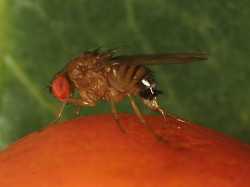SWD, A Game-Changing Pest

For the past decade or more, Mike Omeg’s Integrated Pest Management (IPM) program was like the game plan for a well-coached championship football team. Omeg never had to call an audible, never had to deviate from his list of scripted plays, because his opponents were entirely predictable. Then, one day in 2011, the spotted wing drosophila (SWD) took the field, and this year it blitzed.
Omeg has had to toss the game plans for the 375 acres of cherries he farms in The Dalles, OR, out the window. “We hadn’t used a pyrethroid on our farm in 20 years,” he says, ticking off the secondary pests that have flared as a result of trashing his IPM program. “Now we have leaf miner, black cherry aphid, and mites. I just used a miticide, and I hadn’t used one since the early ’90s.”
Omeg, an American/Western Fruit Grower GenNext Grower (for more, visit GenNextGrowers.com), has also resorted to spraying organophosphates because he just can’t afford to have any SWD found in his sweet cherries. “I’m taking minimal risk,” he says, “which means maximum spraying.”
Beneficials Suffer
Omeg is certainly not alone, says Peter Shearer, an Oregon State University entomologist. Most cherry growers in the Hood River region started spraying pyrethroids early because the SWD, unlike the previous year, caused damage early. The average grower’s spray regimen has changed completely. “We maybe put on an oil prebloom, but that was it,” he says of the good old days. “Now we’ve brought out the arsenal.”
Besides swelling growers’ insecticide budgets, many of the materials used on SWD are lowering the populations of the insects that would prey on such pests as mites and leaf miners. And while growers haven’t seen it yet, Shearer says San Jose Scale might become a problem. “Most of the products we’re using on spotted wing drosophila are rough on beneficial predators,” he says.
There are other unforeseen problems, says Shearer. For example, cherry growers in the region are very dependent on exports for revenue. But some of the countries these growers ship to have zero tolerance for some of the insecticides growers have used, and a detection could mean rejection of an entire shipment. All because growers must have zero tolerance for SWD.
“It’s unfortunate this pest has caused such hardship and is so difficult to control,” he says. “Growers have done such a good job with IPM programs, and now those programs are no longer effective.”
Taking The Fun Out
One potential bright side is that Omeg sees some parallels to the current situation with SWD and the emergence of the oblique-banded leaf roller (OBLR) in the early 1990s when he began growing cherries. At least he hopes so.
Back then OBLR was so new that growers didn’t know how to monitor for pest thresholds, time sprays, or any of the other components of an IPM program. But when he and his fellow growers finally settled on an effective IPM program, it just became part of farming cherries in the Pacific Northwest. “We never really worried about it after that,” he says.
But there’s no surefire way to monitor for SWD. For example, Omeg conducted what he terms a “farmer trial,” and after setting the recommended cider vinegar traps he soon learned that once the fruit starts ripening, the SWD prefers it to the cider vinegar. Monitoring traps became ineffective.
Still, he remains confident, noting that there are an awful lot of scientists working on the problem, hoping the pest will go the way of the OBLR. “I’m hoping to see the same thing with spotted wing drosophila,” he says, “otherwise it’s not going to be fun
to be a farmer.”
Easterners Also Struggle
Growers in the Southeast have also had to trash their carefully constructed IPM programs because of the spotted wing drosophila assault. Growers of blueberries, blackberries, strawberries, and raspberries have sustained the bulk of the SWD damage, says Hannah Burrack, a North Carolina State University Extension entomologist.
“We’ve gone from IPM back to a calendar-based spray program — once a week,” she says. “What makes it worse is we’ve had rain at least once a week all summer.”
Berry growers in the region, much like the cherry growers of the Northwest, are growing strictly for fresh market, so they too have zero intolerance. In 2012, she says some growers sustained notable infestations, so growers have sprayed even more this year. But the rain has really made it difficult to stay on top of SWD.
“It’s a pretty similar year in terms of damage even with a more aggressive program,” she says. “Every day ripening fruit is exposed in the field is a day it can be attacked by the flies.”
Growers are generally spraying insecticides of three general types: spinosyn, pyrethroids, and organophosphates. “But with a calendar-based spray program you need to carefully note how many applications you can make,” she says, “and you must have resistance awareness.”
Any way you look at the situation, says Burrack, the task is daunting. “It’s a challenging critter,” she says. “Zero tolerance is a challenge because you must implement a preventative management strategy, and IPM is built on tolerable thresholds.”









